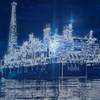Containership design development has grown as rapidly as its gain in popularity as the vessel of choice in many product shipping niches. Germanischer Lloyd's Dr. Hans Payer, who has been on the forefront of containership safety and design issues, examines the strength requirements for large, fast containerships.
The structural safety of modern large container carriers, with their high demands on the hull, could, and still can only be guaranteed by modern methods of analysis. These demands include an extreme deck opening ratio, resulting in considerable deformations due to wave and deck load on hatch covers. Hence, the development of the container vessels was accompanied by continual advancement of computational methods.
Today's Panamax vessel offers up to 4,800 stowage positions, whereby the percentage of deck containers has risen to more than 50 percent. Optimization focuses on minimizing the steel weight and maximizing tonnage, as well as maximizing the stowage positions. Low consumption diesel propulsion engines also contribute towards greater operating economy, with the energy needed per container being only about half that of the third generation container vessels running on steam turbines.
After these optimized containerships were introduced, an increased incidence of forebody damage has been observed, as reported also in a study by the Salvage Association. Typical features include local and global buckling of brackets, wing bulkheads and decks, which considerably reduces the ultimate strength margin of the structure. According to this study, high speeds during bad weather, because of the pressure of time schedules as well as a lack of "seaman's intuition" for extreme loads due to the vessel size, are generally taken as the primary cause of extreme loads higher than previously assumed. Very often, the damage is only noticed in the port of destination, and usually the crew can no longer ascertain the cause.
Ships with a widely flared forebody system have, as was already the case for container carriers of the second generation, a good seakeeping behavior without green water on deck. So from the viewpoint of the shipmaster, there is no reason to reduce speed in a seaway. Only if the danger is recognized, can the risk of foreship damage be reduced ppreciably through changes in speed and course.
It is noticeable that in the North Atlantic, mainly smaller vessels of about 591 ft. (180 m) in length are affected, whereas in the North Pacific it is more so the larger ships. This observation by the Salvage Association is confirmed by the results of a research project conducted by Germanischer Lloyd, in which inter alia the wave-induced loads and bending moments on various container carriers were measured. Similar problems have also occurred on modern cruise liners, where a projecting bow is intended to give the ship the looks of an elegant yacht.
A significant advantage for passenger ships is, however, that the bridge is situated far forward, and the master is thus much closer to the bow action than in a jumbo containership. Nonetheless, there is also in the passenger/ferry ship segment a strong trend towards fast ships: at present, four jumbo ferries and two fast cruise liners are under construction to GL class, all with service speeds of around 28 knots. GL immediately took appropriate action as a result of these findings, and initiated a research project in which, amongst other factors, extreme loads on the forebodies of large and fast ships are being investigated. The development of fast RoRo passenger ferries is the reason why a conventional but very fast (28 knots) RoRo passenger ferry was chosen as the reference ship for the new EU research project DEXTREMEL. In this project, the extreme loads on the ships are being investigated in depth, with the loads on the forebody representing one of the main aspects. Another work package involves determining the structural reserve strength for the elements of a damaged structure and, associated with this, an investigation of the possibilities for enlarging this residual structural strength without increasing the steel weight appreciably. In these studies, peak pressures cased by slamming are being calculated for a variety of bow shapes using modern methods such as computational fluid dynamics. Naturally, the results obtained from the example of a fast RoRo passenger ferry can be transferred fully to other ship types including the container carriers mentioned.
The initial results have already been incorporated into the new edition of the Construction Rules for Hull Structures (Edition 1998). The new regulations include increased design pressures for the forebody structure, including the forecastle, together with structural requirements and guidelines on increasing the ultimate strength under extreme loads. The consideration of stresses caused by hydrodynamic impact forces on the forebody, as part of the global analyses of the large containerships, is the current state-of-the-art ship structural analysis at Germanischer Lloyd.
Just how urgent these amendment to the Rules are with a view to improving the operational safety of modern containerships can be seen from the fact that responsible-minded shipowners - after having been informed by GL - have already, before official publication, made them a contractual requirement for their order of Panamax as well as post-Panamax vessels.
Sponsored Content
Experience Custom Yacht Signs and Designs Tailored to Perfection!

April 2025
 Read the Magazine
Read the Magazine

 Read the Magazine
Read the Magazine
This issue sponsored by:

From Oil to Wind: Cross-Skill Pilot Exemplifies Just-Transition in Action
Subscribe for
Maritime Reporter E-News
Maritime Reporter E-News is the maritime industry's largest circulation and most authoritative ENews Service, delivered to your Email five times per week






